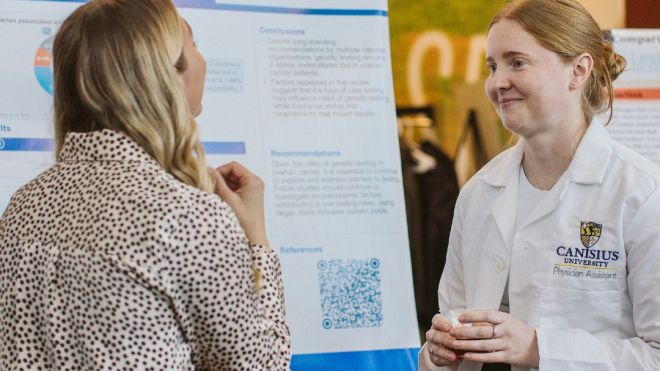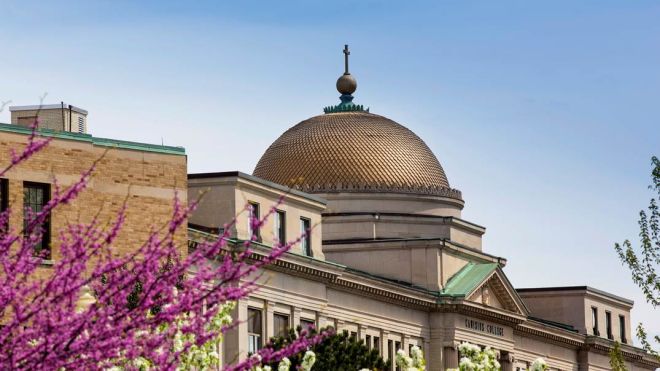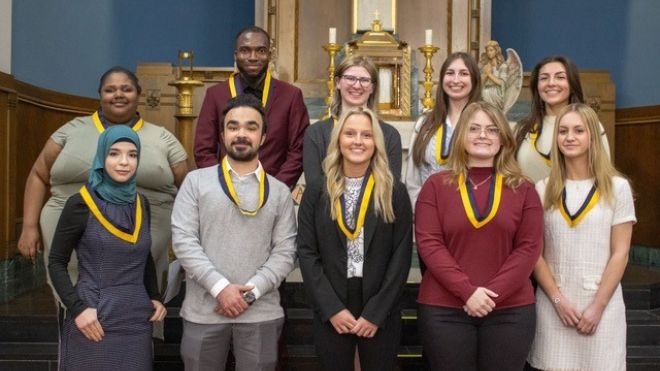BUFFALO, NY - Canisius President John J. Hurley and his wife, Maureen, recently returned from their pilgrimage through the Holy Land. Below, President Hurley shares his final reflections and photos from the week-long pilgrimage, which was sponsored by America Media, a Jesuit ministry that includes America magazine. The trip was led by Revs. James Martin, S.J., author of Jesus: A Pilgrimage; Matt Malone, S.J., editor-in-chief of America; and Brendan Lally, S.J., rector of the Jesuit community at St. Joseph’s University.
Readers can take a viritual pilgrimage to the Holy Land by following journeys.americamagazine.org.
Final Reflections from the Holy Land

Jerusalem at sunset
Thank you for following my pilgrimage to the Holy Land. This was a unique opportunity to explore my personal relationship with Jesus Christ in a new and vivid way by tracing his steps in the Holy Land.
I tell our students at Open Houses and at Freshman Convocation that I hope that they will find – as St. Ignatius Loyola did – that life is all about a relationship with God and it is the process of exploring that relationship that brings about a transformation in human beings. I’ve always believed that to be true, but the experiences of the past week have confirmed it for me again.
I have tried to make these reflections something more than just a travelogue. There is no doubt that the places we visited and the things that we saw were an important part of the experience. We had the opportunity to see the places where Jesus actually lived, walked, preached, healed, died and rose from the dead. We learned that not every single detail can be pinned down with absolute certainty and a certain amount of it is part of the wonderful mystery of our faith. But, in the end, I am left with a much better appreciation of Jesus as fully human and fully divine.

The Sea of Galilee
When our Canisius students go on retreats or service or immersion trips, we warn them at the end that it is very likely that they will be flooded with emotions because of the intensity of the experience. I am no different, and in addition to the emotions, I’m left with some essential questions that Fr. Jim Martin posed to us on the last day of the pilgrimage:
Where did I meet God on this journey and where did God move me?
What did I learn about Jesus on this journey and how am I closer to him?
What do all of these experiences mean and what difference will they make in my life?
These are lifetime questions. No matter how holy or significant the site you visit may be, it’s never a “one and done” proposition. Our relationship with God needs to be a lifetime journey. Stay tuned!
Days 6 & 7 – Bethlehem and Jerusalem

Jerusalem
The final two days of our Holy Land pilgrimage book-ended the life of Jesus: his birth in Bethlehem and his death in Jerusalem before his Resurrection on Easter Sunday. Fr. Jim Martin observed that Jesus entered and left this world in the most vulnerable of states: birth in a lowly cave in Bethlehem and death on a cross.
The Church of the Nativity in Bethlehem is a noisy, bustling shrine, made more so by extensive restoration and repairs that are underway under the supervision of Bethlehem’s Palestinian government. You are able to venerate the exact place where Jesus was born and also the place where he was placed in the manger, which is not the stable (a creation of St. Francis of Assisi), but is actually a cave.

The Nativity Grotto in Bethlehem
The purpose of our trip was religious and we intentionally avoided getting into the difficult political dynamics of Israel and the Middle East, butthe wall that has been built around Palestinian-controlled Bethlehem is a stark reminder of the elusiveness of peace. The experience served to intensify our prayers each day for a true, just and lasting peace in the Holy Land

The Stations of the Cross on the Via Dolorosa
Our final day was a whirlwind trip through many famous sites in Jerusalem: We prayedthe Stations of the Cross and carried the cross on the Via Dolorosa. We celebrated Mass at Crucifixion Chapel in the Church of the Holy Sepulchre. We visited Peter in Gallinctu, the dungeon in which Jesus was held by the high priest on Holy Thursday night; we prayed at the site of the Upper Room; we saw the Pool of Bethesda, the site of the healing of the paralytic in John’s Gospel; and we made a final stop at the Western, or Wailing, Wall where we were able to pray with our Jewish brethren.

The Wailing Wall
In walking through this ancient holy city, you are struck by the tremendous diversity. The narrow, almost claustrophobic streets of the city are home to hundreds and hundreds of shops offering Jewish, Christian and Muslim wares. Observant Jews with prayer shawls and young children in tow were out on Saturday making their way to temple and back home again. The Arab music of the shopkeepers on the Via Dolorosa merges with our own chant of “Jesus, remember me when you come into your kingdom.” The prayers at the Wailing Wall are joined with the hauntingly beautiful call to prayer from the Muslim Quarter. Tomorrow: A final reflection from the Holy Land
Day Five - Thursday, April 23
Reflections from the Holy Land, President John J. Hurley

The Garden of
Gethsemane
We are in Jerusalem, the Holy City in the Holy Land. Unlike our time in Galilee where we enjoyed temperatures in the 70s and 80s, the thermometer dropped into the 40s last night and it was cold and windy with a little rain today.
We celebrated Mass this morning at the Gethsemane Basilica. In the sanctuary is the rock which is purported to be the stone upon which Jesus prayed in the garden on Holy Thursday. We sat close together on stools in the sanctuary and had an opportunity to contemplate and venerate the rock. Following Mass, there was time for reflection in a private section of the Garden of Gethsemane. Fr. Jim Martin talked this morning about Jesus coming to grips with God's plan for him, and he asked us if there was something that we would like to surrender to.

The site of
the Ascension
We visited the Ascension Chapel on the Mount of Olives where, again, there is a stone which is reported to be the stone from which the Ascension took place. Interestingly, the site is shared by Christians and Muslims and we had a large contingent of Muslim pilgrims in the same space with us.
The afternoon was spent at the Church of the Holy Sepulchre, a structure dating back to the 13th century that contains the site of Jesus's crucifixion (Golgotha), his descent from the cross, his internment in the tomb and his resurrection on Easter Sunday. This is not legend; scholars agree that these are the actual sites. It is almost too much to comprehend in such a concentrated space, and the hordes of pilgrims - Roman Catholics, Greek Orthodox, Coptic Christians, Syrians, Armenians, and Ethiopians - do not make the task any easier. But you are actually able to touch the spot on Calvary where the cross stood and you can venerate the tomb of Christ, all of which is very, very powerful.

Golgotha
Every evening, we conduct faith sharing with our group, as we do at Canisius on student retreats and during our service and immersion trips with students. These are deep moments of reflection that reveal the many ways in which the Holy Spirit is working among all of us. As amazing as this pilgrimage has been, the work of the Holy Spirit in so many different ways is perhaps most amazing of all.

The Tomb of Christ
Day Four - Wednesday, April 22
Reflections from the Holy Land, President John J. Hurley

Pilgrims preparing to enter the Jordan River
We departed from the Mount of Beatitudes this morning and drove to the "other side" of the Sea of Galilee and down through the West Bank to Jericho, Bethany and finally, Jerusalem.
On our bus ride, we received some orientation to the modern day political reality of Israel. We drove through checkpoints, saw armed guards, barriers and fences, and got a much better sense of the division in the country.
We visited the site on the Jordan River where Jesus was baptized by John the Baptist. I stood in the murky Jordan River (not opting for the full immersion sought by many other pilgrims; after all, we Catholics have already been baptized!) as Fr. Brendan Lally led us in a renewal of our baptismal vows. As with so many other parts of this pilgrimage, those vows took on new meaning at this holy site.

President Hurley in the Jordan River
We continued on to Bethany, which now is a Palestinian-controlled town, to see the tomb of Lazarus. I have been praying over St. John's account of Jesus's greatest miracle, the raising of Lazarus, for many years. At funerals, I find Jesus's announcement that he is the resurrection and the life and those that live and believe in him will never die to be a source of great consolation. Never in my life did I imagine that I would be standing in Lazarus's tomb. Fr. Jim Martin's great reflection for us this morning asked is to think about what in our lives we might want to leave behind in that tomb. It was a powerful moment for everyone in our party.
We arrived tonight in Jerusalem, leaving Christ's ministry in Galilee behind, and preparing to trace the final steps of his life in this holy city.
Day Three - Tuesday, April 21
Reflections from the Holy Land, President John J. Hurley

Fr. Jim Martin, S.J. celebrates Mass on the Mount
of the Beatitudes assisted by Fr. Brendan Lally, S.J.
and Fr. Matt Malone, S.J.
We celebrated Mass outside on the grounds of the Mt. Beatitudes Guest House overlooking the Sea of Galilee. I am hard pressed to think of a more beautiful setting to celebrate the liturgy. Our Gospel reading was, of course, the Beatitudes from St. Matthew's Gospel, each one of which took on new meaning in this special place.

Eremos Cave
We walked down the hill from the guest house to the Eremos Cave, which is believed to be a secluded place where Jesus went to pray. Fr. Brendan Lally, as he has done each day, did a wonderful job of centering us on the experience. He asked us to imagine walking alongside Jesus down this path and to imagine sitting beside Jesus in quiet prayer in the cave.

The path down the Mount of the Beatitudes
We had a similar prayerful time in Bethsaida, the home of Apostles Peter, Andrew and Phillip. We were encouraged to spend some quiet time pondering the call of the Apostles. In his opening talk this morning, Fr. Jim Martin observed that the Apostles were convinced to follow Jesus after he sent them out to cast their nets one more time. When Peter sees the fish in the net, he becomes convinced of what God can do and it enables him to say "yes" to God's call. And in our own lives, aren't our own nets already full of the proof of what God can do? What holds us back from saying yes?
We had lunch in Magdala today, and while the food was wonderful, the company of our fellow pilgrims was the highlight. We number about 45 and it is a most interesting group that is absorbing every moment of this experience. The hunger for spiritual nourishment among our group is palpable. We are blessed to be among them.
Day Two – Monday, April 20
Reflections from the Holy Land, President John J. Hurley

The Grotto
Our Holy Land pilgrimage continued today with visits to Cana and Nazareth. Fr. Jim Martin opened this morning with a reflection in the chapel at Cana, the site of the Wedding Feast at Cana, Jesus's first miracle. He told us again that neither he nor any of the other Jesuits with us are directing this pilgrimage; we are in the hands of the Holy Spirit who is directing us.
We all had an opportunity to renew our vows this morning and it was an especially poignant moment when Maureen and I renewed our vows in that chapel after 32 years of marriage. I joked afterwards that it was like pulling into the repair shop for a little tuneup. In the courtyard outside the chapel afterwards, one of our party went across the street to the Cana Wedding Wine Shop and got us all samples of red wine to taste and celebrate.
We traveled on to Nazareth, which at the time of Jesus's birth, was a town of about 150-200 residents but which today has grown into a diverse, busy city. The highlight of today was our visit to the Basilica of the Anunciation. We visited the grotto underneath the Basilica where the Angel Gabriel appeared to Mary and announced that Mary was to be the Mother of God. This is one of the most beautiful stories in the New Testament and it remains a challenge for all of us today.

The Basilica of the Annunciation
Both Fr. Martin in his opening remarks this morning and Fr. Brendan Lally in our Mass celebrated at the Basilica this afternoon, asked us to look for places in our lives where God is inviting us to say yes. To be present at the site where Mary delivered the yes that changed the course of the world was a powerful spiritual experience, indeed.
I remembered in my intentions today my father who died 9 years ago today. In the course of his 88 years and raising 9 children, I know that he had many opportunities to say, as Mary did to the Angel Gabriel, "Be it done unto me according to your word." I gave thanks today for his life and his example.
Day One – Sunday, April 19
Reflections from the Holy Land, President John J. Hurley
We arrived here last night after dark at the Mt. Beatitudes Guest House, high on the hill above the Sea of Galilee and near the place where Jesus spoke the Beatitudes (Matthew 5:1-16). Our pilgrimage leader, Fr. Jim Martin, has stressed to us the need to make this trip a true pilgrimage and to allow God to work with and through us during the week. We did not choose to make this pilgrimage, he told us; rather, God has chosen us. And as we got our first view of the Sea of Galilee this morning, he reminded us all of the Apostles who were called by Jesus right here, with words, “Come, follow me.” He challenged us, “What is our response?”
The Synagogue at Capernaum

The Synagogue at Capernaum
Today, we visited Capernaum, the place where Jesus lived after leaving Nazarerth. We saw the place where he preached in the synagogue (now replaced by a fourth century synagogue). Adjacent to the synagogue is the excavated village of Capernaum, the site of so many miracles in Mark’s Gospel. We also visited Tabgha, site of the multiplication of the loaves and fishes, and the seashore where Jesus appeared again to the Apostles after the Resurrection and established Peter as the leader of the Church here on earth.
The Gospel reading for Saturday was John’s account of Jesus walking on the water at night while the disciples’ boat was caught in some strong winds. When the disciples saw Jesus walking on the water, they were frightened. His words, repeated in many other places in the New Testament, were, “It is I, do not be afraid.” At the end of this wonderful first day, I pray with these thoughts: God has called me to this pilgrimage; Jesus called the apostles to follow him; I have now seen the places where Jesus astonished so many with his miracles; life is full of dark and stormy nights which frighten us; and I wonder where I might encounter Jesus this week. I am consoled with the words in John’s Gospel: “It is I. Do not be afraid.”
I have the entire Canisius community – students, faculty, staff, alumni and friends – in my prayers and intentions this week.



